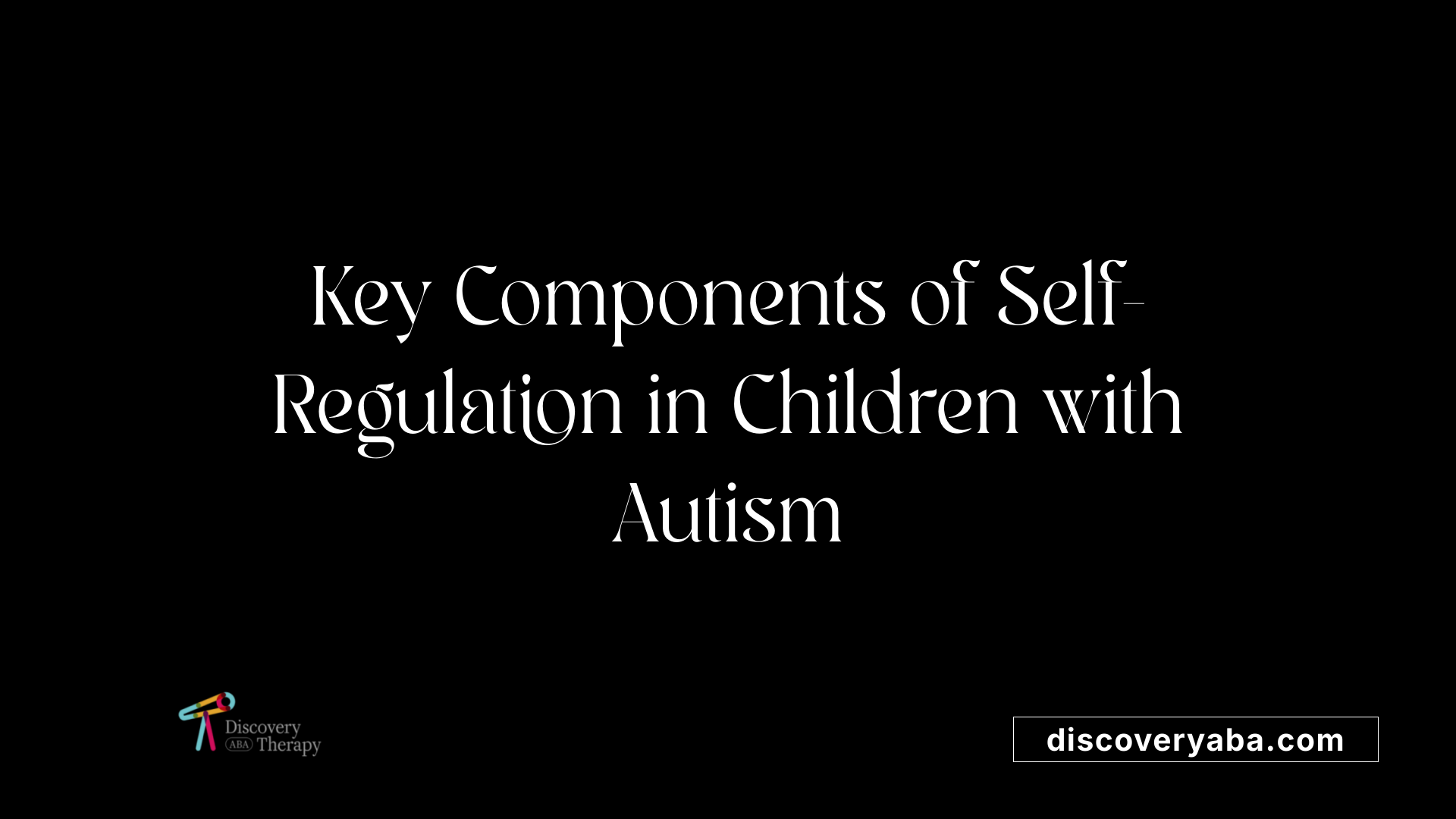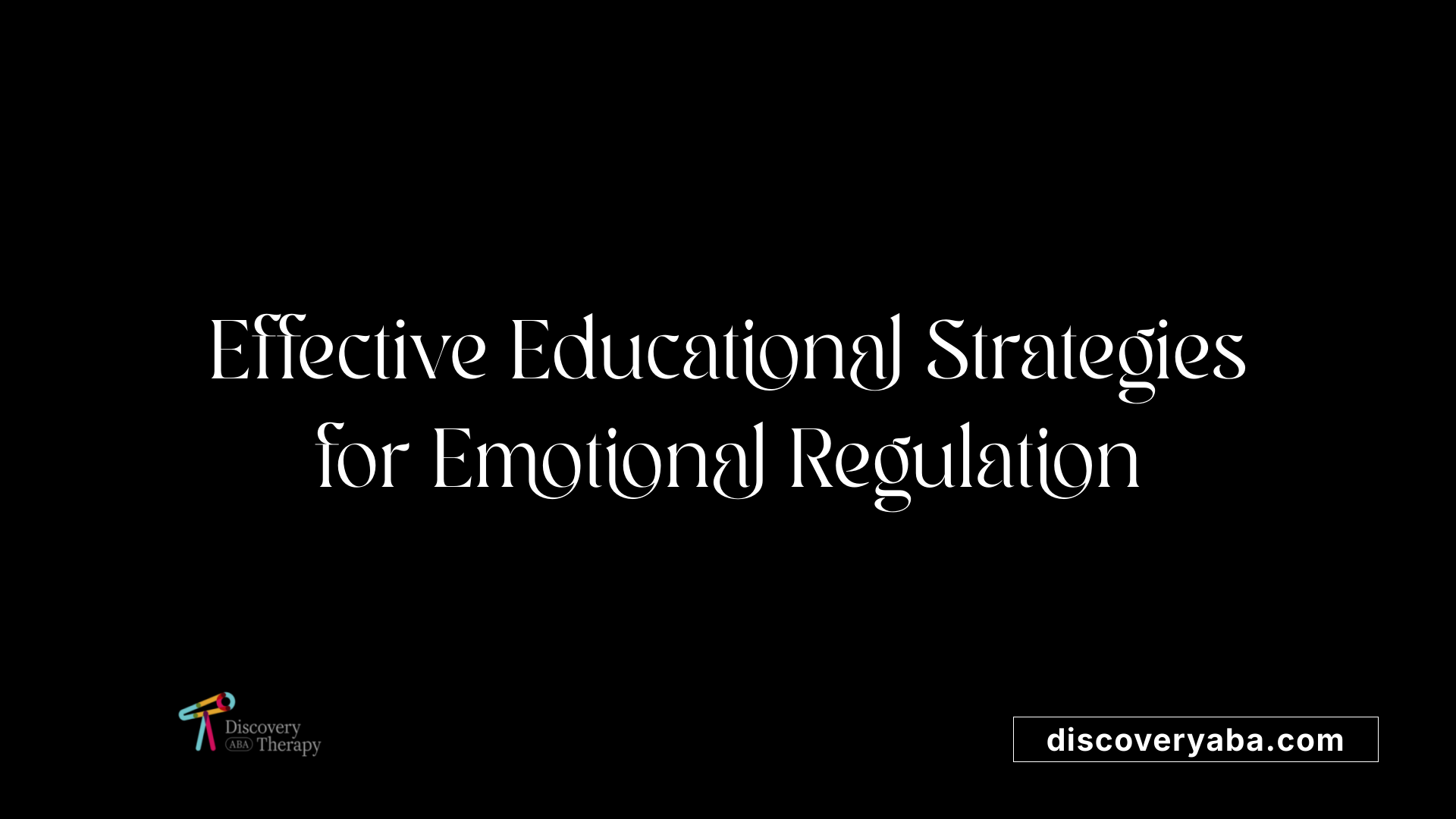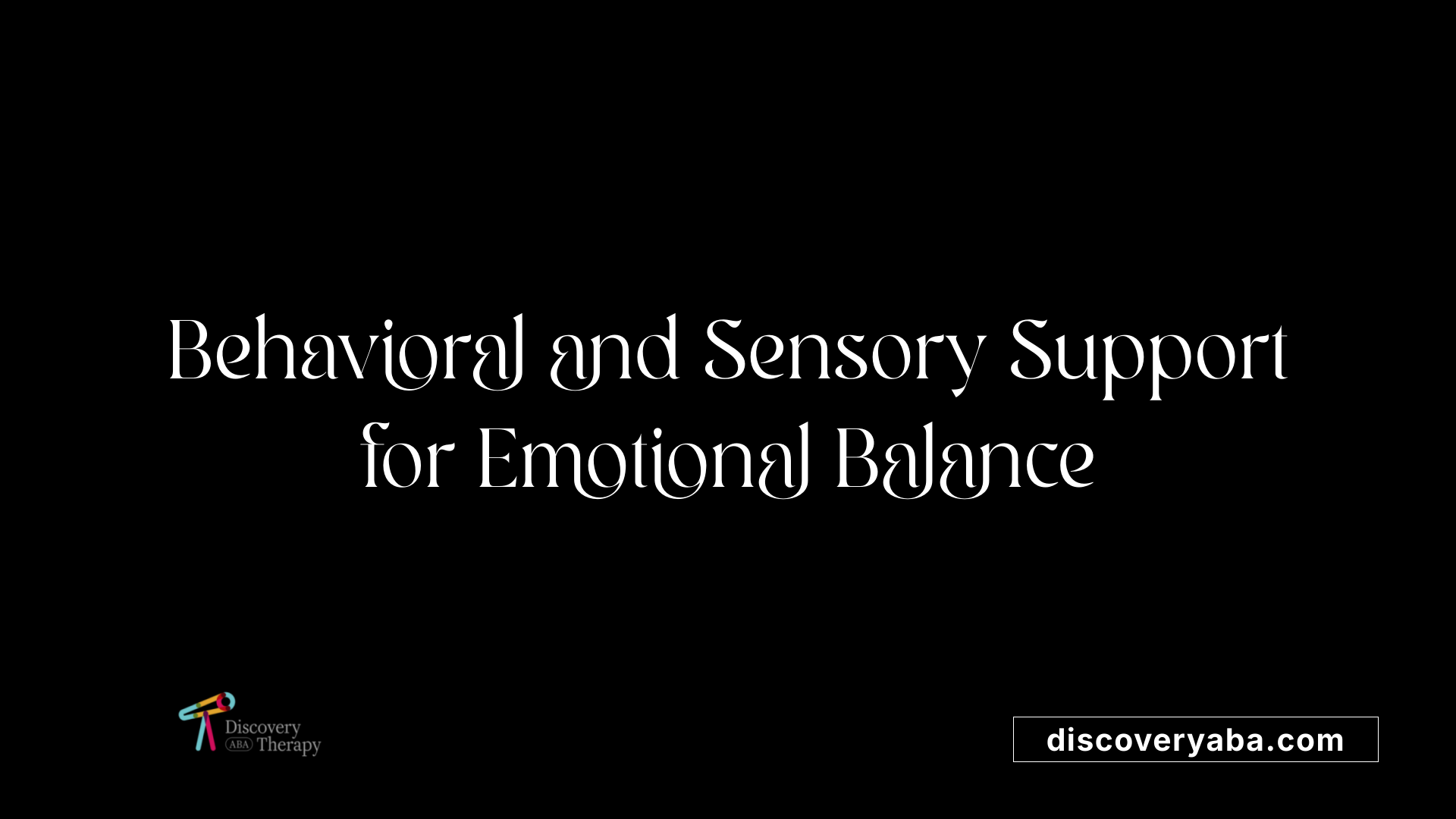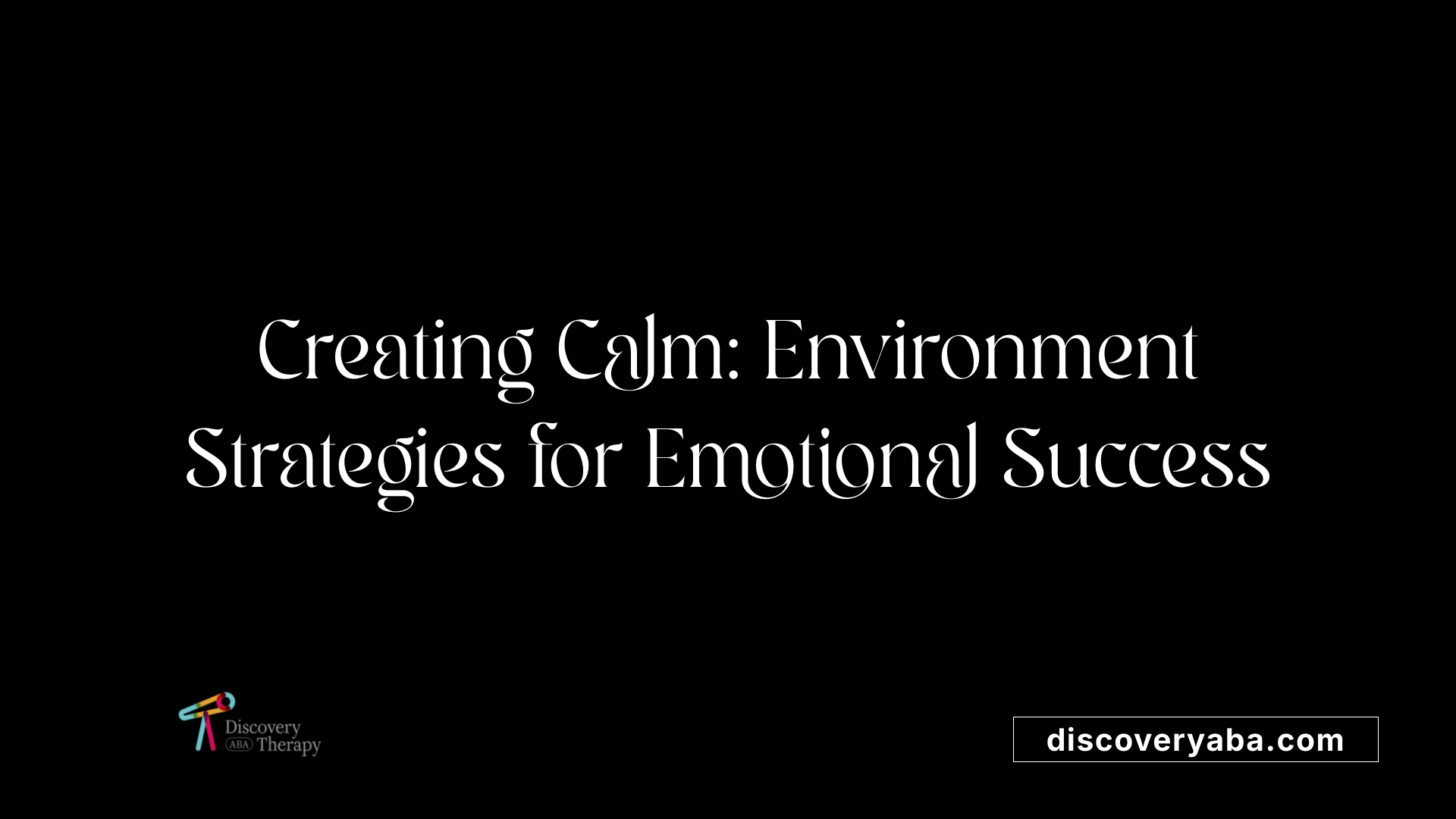Can ABA support emotional regulation in autistic children
Unlocking Emotional Balance through ABA

Understanding How ABA Facilitates Emotional Self-Regulation in Autism
Autism Spectrum Disorder (ASD) presents unique challenges in emotional self-regulation, impacting social interactions, behavior, and daily functioning. Applied Behavior Analysis (ABA) has emerged as a structured, evidence-based approach to support children with autism in developing these essential skills. This article explores how ABA can effectively aid in improving emotional regulation, examining strategies, benefits, and the vital role of educational and behavioral interventions.
The Foundations of Self-Regulation in Autism

What is self-regulation and why is it important for children with autism?
Self-regulation means managing emotions, behaviors, and thoughts to respond effectively to different situations. For children with autism, mastering these skills is vital. It helps them navigate social interactions more smoothly, reduces behaviors that might be challenging or disruptive, and promotes greater independence in daily life.
Children with autism often face unique challenges, such as heightened sensory sensitivities and difficulties in communication. Developing self-regulation enables them to handle unexpected events better and stay calmer in stressful or new situations. This not only enhances their emotional well-being but also supports their ability to learn, build relationships, and participate fully in their communities.
What are the components of self-regulation?
Self-regulation comprises three main parts:
Emotional regulation: Managing feelings like anger, frustration, or excitement. Helping children understand and respond to their emotions healthily is essential.
Cognitive regulation: This involves self-control, focus, and problem-solving. It helps children think clearly and manage thoughts that might lead to impulsive actions.
Behavioral regulation: Governing actions based on internal cues and external expectations. It includes actions like waiting patiently, controlling impulses, and following routines.
Teaching these areas through structured activities, modeling, and positive reinforcement can significantly support children with autism. Using tools like visual aids, routines, and sensory supports can make learning these skills more effective.
Fostering strong self-regulation skills in children with autism leads to more positive daily experiences, better social engagement, and enhanced overall development, setting a foundation for long-term success.
Educational Approaches to Emotional Regulation

What educational approaches can help develop emotional regulation skills in autistic children?
Supporting emotional regulation in children with autism involves a variety of teaching methods designed to help them understand and manage their feelings effectively. One fundamental approach is teaching children to recognize and label different emotions. Using visual supports such as emotional charts, social stories, and the Zones of Regulation framework helps children identify their current emotional state and understand the associated behaviors.
The Zones of Regulation categorizes emotions into four color zones—blue, green, yellow, and red—making it easier for children to pinpoint their feelings and develop strategies to transition between zones calmly. Social stories describe specific emotional responses and social situations, providing children with cues on appropriate reactions.
Incorporating coping strategies is essential. Techniques such as deep breathing, movement breaks, and calming activities like listening to music or using sensory tools (weighted blankets, fidget toys, noise-canceling headphones) help children manage intense feelings and sensory overloads.
Establishing predictable routines and structured environments creates stability, reducing anxiety and facilitating emotional regulation. Consistent routines help children anticipate daily events, making emotional responses more predictable and manageable.
Modeling calm and positive behavior is another critical component. When educators, caregivers, and therapists demonstrate self-regulation, children learn by imitation. Clear and simple communication, along with teaching problem-solving skills during calm moments, reinforces emotional understanding.
Collaboration plays a vital role. Regular coordination among teachers, parents, and therapists ensures that teaching strategies are consistent and tailored to the child's needs. This team effort ensures a comprehensive approach to developing emotional regulation skills in children with autism.
| Strategy | Description | Tools/Examples |
|---|---|---|
| Recognition and Labeling | Teaching children to identify their emotions | Emotional charts, social stories, zones of regulation |
| Visual Supports | Using visual cues to support emotional understanding | Color-coded zones, emotion flashcards |
| Coping Strategies | Helping children manage feelings during heightened states | Deep breathing, movement breaks, calming activities |
| Routines and Structure | Creating predictable daily schedules | Visual schedules, consistent routines |
| Modeling and Communication | Demonstrating self-regulation and clear social cues | Calm behavior, simple language |
| Collaboration | Working with caregivers and therapists for personalized plans | Team meetings, shared strategies |
Implementing these approaches through consistent practice and tailored strategies significantly enhances emotional regulation, fostering better behavior, social skills, and overall well-being in children with autism.
The Impact of ABA Therapy on Emotional Skills
ABA therapy plays a vital role in helping children with autism develop better emotional recognition and control. Through structured and repetitive teaching, children learn to identify and label different emotions, which is essential for social interactions.
One effective method ABA uses is the implementation of social stories. These short, visual narratives describe social situations and appropriate emotional responses, helping children anticipate behaviors and understand feelings in various contexts. Perspective-taking exercises are also common, where children practice understanding others' viewpoints, fostering empathy and emotional awareness.
In addition to stories and exercises, ABA utilizes behavioral strategies such as reinforcement, modeling, and role-playing. Positive reinforcement encourages children to repeat desirable behaviors, while modeling demonstrates appropriate emotional responses. Role-playing provides opportunities to practice emotions and social skills in a safe environment. These techniques collectively help children learn healthy ways to express and manage their feelings.
A major focus of ABA is addressing challenging behaviors by understanding their triggers. Therapists identify specific stimuli or situations that lead to difficulties and teach replacement behaviors. For example, a child may learn to request a break instead of throwing a tantrum. This helps reduce problematic behaviors and promotes emotional regulation.
The benefits of applying ABA therapy in this context are significant. Children tend to show improved emotional understanding, leading to fewer meltdowns and better social skills. As they become more adept at managing their emotions, their independence and overall well-being increase.
Supporting emotional regulation involves multiple strategies. Visual supports like the Zones of Regulation help children categorize their feelings into manageable zones, making it easier to identify and control emotions. Sensory tools such as weighted blankets or noise-canceling headphones also help children manage sensory overload, which can trigger emotional outbursts.
In summary, ABA therapy offers a comprehensive approach to teaching emotional skills. From recognizing feelings to responding appropriately, the methods used foster stability and healthier social interactions. This results in happier, more confident children who are better equipped to navigate their emotional landscape and social environments.
How ABA Supports Emotional Awareness and Expression
How can ABA therapy support emotional regulation in autistic children?
ABA therapy plays a significant role in helping children with autism understand, label, and express their emotions effectively. It uses a structured approach that incorporates visual aids like feelings charts and the Zones of Regulation, which categorize emotions into four distinct color zones. This visual framework helps children identify their feelings and recognize changes in emotional states.
Functional communication training is another cornerstone of ABA intervention. It teaches children to convey their emotions clearly, either verbally or through alternative communication methods, reducing frustration and challenging behaviors caused by difficulty in expressing feelings.
Additionally, ABA promotes social skills development through activities like role-playing and perspective-taking exercises. These techniques foster empathy, enabling children to better understand their own emotions and those of others. Reinforcement strategies further encourage children to express their feelings appropriately, strengthening emotional regulation skills.
Strategies for Teaching Emotional Regulation
- Use visual tools such as emotion charts and color-coded zones to help children recognize different feelings.
- Break down complex emotional responses into manageable steps.
- Implement stories about emotions to build understanding.
- Practice relaxation and mindfulness techniques during calm moments.
- Integrate sensory tools like weighted blankets or noise-canceling headphones to help manage sensory sensitivities.
The Impact of Supporting Emotional Skills
Developing emotional regulation can significantly enhance a child's daily happiness, social interactions, and overall learning. When children learn to identify, understand, and appropriately respond to their emotions, they are more likely to display adaptive behaviors and form positive relationships.
Additional Support Methods
Incorporating visual aids such as feelings charts and the Zones of Regulation provides constant references for emotional awareness. Social skills training within ABA encourages empathy and understanding, fostering better peer interactions. Reinforcement strategies motivate children to practice these skills consistently.
| Method | Focus Area | Tools/Techniques | Benefits |
|---|---|---|---|
| Visual Aids | Emotional recognition | Feelings charts, Zones of Regulation, story-telling | Better identification of emotions, reduced frustration |
| Communication Strategies | Expressing feelings | Role-playing, functional communication training | Better emotional expression, less behavioral issues |
| Social Skills Training | Empathy and perspective-taking | Turn-taking games, social stories | Stronger social understanding and interactions |
| Reinforcement | Encouragement of appropriate responses | Rewards, positive feedback | Increased emotional awareness and regulation |
In summary, ABA therapy offers targeted, step-by-step support to develop emotional awareness and expression in children with autism, employing visual aids, social skills training, and reinforcement strategies to foster meaningful progress in emotional regulation.
Behavioral Techniques and Sensory Support Strategies

How can behavioral interventions support emotional regulation in autistic children?
Behavioral interventions play a vital role in helping children with autism develop better emotional regulation skills. These techniques involve teaching children coping methods, establishing structured routines, and responding to emotions through reinforcement and visual cues. For example, using visual supports like social stories or emotion charts helps children recognize and understand their feelings.
In addition, sensory tools such as weighted blankets, fidget toys, and noise-canceling headphones are effective in managing sensory overload, which often impacts emotional stability. These tools provide calming sensory input that helps children feel more secure and ready to engage in other self-regulation activities.
Incorporating calming activities, like deep breathing exercises and sensory-integrated spaces, creates a safe environment where children can self-soothe during overwhelming moments. Routine implementation of sensory and behavioral strategies in daily activities ensures consistent support for emotional regulation, making it easier for children to adapt and respond positively in different situations.
Use of sensory tools like weighted blankets, fidget toys, noise-canceling headphones
Sensory tools are essential for supporting children with autism in managing their sensory sensitivities. Weighted blankets provide gentle, deep pressure that can promote relaxation and reduce anxiety. Fidget toys allow children to focus their sensory input, helping to decrease restlessness and improve concentration.
Noise-canceling headphones help diminish auditory overstimulation, creating a calmer environment and preventing emotional meltdowns. These tools can be used during quiet times, in noisy settings, or as part of calming routines.
Sensory-integrated activities and calming spaces
Engaging children in sensory-integrated activities, such as swinging, bouncing on therapy balls, or playing with textured materials, supports their sensory processing skills. These activities can regulate sensory input and reduce hyper- or hypo-sensitivity.
Creating designated calming spaces filled with soft lighting, calming visuals, and sensory tools offers a retreat for children to reset their emotional state. These sanctuaries help children learn to self-regulate and regain composure.
Role of routines, visual supports, and calming techniques like deep breathing
Establishing predictable routines provides a sense of security, reducing anxiety and emotional outbursts. Visual supports like schedules and timers help children anticipate transitions and understand expectations.
Calming techniques such as deep breathing, visual relaxation exercises, and mindfulness moments teach children to manage stress in real-time. Practicing these during calm moments encourages their use during challenging situations.
Implementation of sensory and behavioral interventions in daily routines
Integrating sensory and behavioral strategies seamlessly into daily routines ensures consistency and effectiveness. For instance, incorporating sensory breaks between learning activities, using visual cues for transitions, and applying reinforcement systems support ongoing emotional regulation.
Caregivers and educators play a crucial role in maintaining these practices, adapting interventions to each child's needs, and reinforcing skills through positive feedback.
| Strategy | Description | Goal |
|---|---|---|
| Use of sensory tools | Weighted blankets, fidget toys, noise-canceling headphones | Minimize sensory overload, promote calmness |
| Sensory-integrated activities | Swinging, textured play, bouncing | Regulate sensory input, improve processing |
| Calming spaces | Quiet rooms with visual and sensory supports | Provide safe space for self-regulation |
| Routines and visual supports | Schedules, timers, visual cues | Reduce anxiety, clarify expectations |
| Deep breathing and mindfulness | Breathing exercises, visual relaxation | Teach stress management skills |
Fostering these strategies in daily routines can greatly enhance emotional resilience, social interactions, and overall well-being for children with autism.
Creating a Supportive Environment for Emotional Regulation
 A supportive environment is essential for helping children with autism develop emotional regulation skills. Such environments include calming spaces, sensory tools, and consistent routines that help children manage sensory sensitivities and emotional responses effectively.
A supportive environment is essential for helping children with autism develop emotional regulation skills. Such environments include calming spaces, sensory tools, and consistent routines that help children manage sensory sensitivities and emotional responses effectively.
Calming spaces provide a quiet, comfortable area where children can retreat when overwhelmed. Sensory tools like weighted blankets, fidget toys, and noise-canceling headphones support sensory regulation, making it easier for children to stay calm and focused.
Positive reinforcement is crucial in encouraging desired behaviors. Using praise, rewards, or preferred activities strengthens emotional regulation skills and fosters confidence. Reinforcement schedules ensure that children continue to engage positively with their environment.
Caregivers and educators play a vital role by actively monitoring progress and adjusting strategies as needed. They observe emotional responses and introduce naturalistic interventions, embedding emotional regulation support into daily routines and activities. This approach helps children learn to identify, understand, and manage their emotions in a natural, ongoing context.
Building resilience through these strategies prepares children for various social situations. When implemented consistently, a supportive environment nurtures independence, improves social interactions, and promotes overall emotional well-being.
Fostering Emotional Growth with ABA
ABA therapy, integrated with educational strategies, sensory support, and positive reinforcement, offers a comprehensive approach to enhancing emotional regulation in children with autism. By teaching recognition, expression, and coping skills within a structured, nurturing environment, ABA fosters emotional resilience, independence, and improved social interactions, empowering children to navigate their worlds with confidence.
References
- Children with Autism: The Importance of Self-Regulation Skills
- Strategies for Teaching Emotion Regulation Skills to Children
- How Does ABA Help with Emotions in Autism?
- 4 Ways To Help Your Child with Autism Self-Regulate
- Emotion Regulation: Concepts & Practice in Autism Spectrum Disorder
- What is Emotional Regulation? Breaking Down the Basics for ABA ...
- Practical Strategies to Teach Emotional Regulation Skills in ABA ...
- Simple evidence-based strategies for teaching emotion regulation?
- Emotion Regulation: Concepts & Practice in Autism Spectrum Disorder
- Behavioral Interventions for Autism Spectrum Disorder
Find More Articles
Contact us
North Carolina, Tennessee, Nevada, New Jersey, Utah, Virginia
New Hampshire, Maine
Massachusetts, Indiana, Arizona, Georgia
.avif)















































%2520(1).jpeg)































.jpeg)














